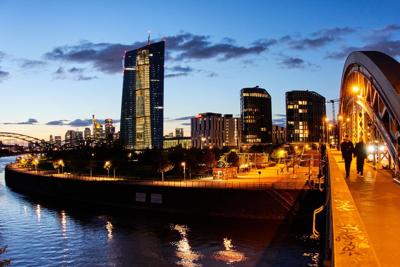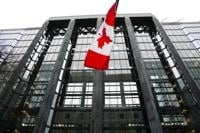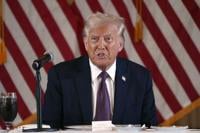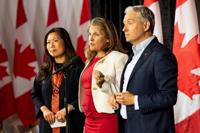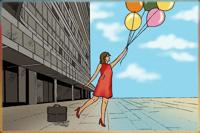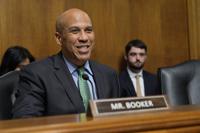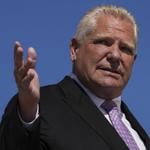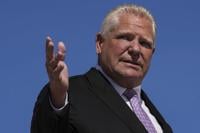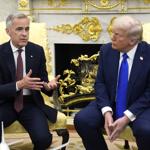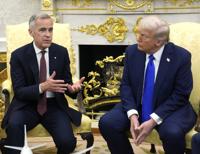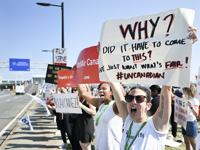FRANKFURT, Germany (AP) — The European Central Bank left its key interest rate unchanged Thursday as inflation remains under control and European businesses weather the impact of higher U.S. tariffs better than previously feared.
The bank’s deposit rate has stayed at 2% now for the third meeting in a row. The bank has entered a holding pattern after cutting the rate from 4% to snuff out double-digit inflation caused by the rebound from the pandemic and higher energy prices.
A slightly brighter outlook has removed pressure to enact another cut, although growth remains modest.
While the central bank has done its job getting inflation under control, growth concerns are now focused more broadly on Europe’s economic competitiveness in areas beyond the control of the ECB. A report by former ECB head Mario Draghi has called for widespread reforms to reduce bureaucracy and increase investment and innovation as Europe faces increasing competition from China and higher tariffs from the US under President Donald Trump.
“The economy has continued to grow despite the challenging global environment,” bank President Christine Lagarde said at her post-meeting news conference. “However, the outlook is still uncertain, owing particularly to ongoing global trade disputes and geopolitical tensions.”
The ECB said further decisions would be taken meeting to meeting and be based on the latest incoming data available at that time.
Thursday's meeting took place in Florence, Italy - one of the occasional meetings held away from the bank’s Frankfurt headquarters to underline its role as a pan-European institution.
Recent surveys of European business activity have shown a modest upswing at the start of the fourth quarter despite the imposition of a 15% tariff, or import tax, on European goods by U.S. President Donald Trump. That follows growth of 0.2% in the third quarter over the quarter before, and 1.3% higher than the same quarter a year ago.
With inflation under control at 2.2% in September, just above the bank’s 2% target, analysts say the central bank for the 20 countries that use the euro may not change rates again until sometime next year. Lower rates tend to support growth, while higher rates are used to fight inflation.
The stand-pat approach at the ECB is a sharp contrast to that of the U.S. Federal Reserve, which cut rates a quarter percentage point on Wednesday and could cut again in December to support growth, even as US inflation remains elevated. Fed Chair Jerome Powell said however another cut is not "a foregone conclusion.”
Europe’s economy grew by a modest 0.2% in the third quarter, official figures showed Thursday. Growth in the 20 countries that use the euro was held by back and anemic performances by Germany and Italy, both of which barely avoided a technical recession.
, with zero growth in the August-September third quarter, following a contraction of 0.2% in the second quarter, figures from EU statistics agency Eurostat showed. Two straight quarters of falling output is one frequently used definition of recession. Italy likewise turned in zero growth after contracting by 0.1% in the second quarter.
Germany's manufacturing- and export-focused economy has been held back by multiple factors including higher energy prices, competition from Chinese producers of autos and industrial machinery, a lack of skilled workers and excessive bureaucracy.
Another headwind for Europe comes from President Donald Trump's imposition of a 15% tariff, or import tax, on goods brought to the U.S. from Europe, as well as from the uncertainty spread by back-and-forth talks with the European Union’s executive Commission. over possible higher tariff rates.
The ECB left its at its previous two meetings in July and September. The bank has cut its benchmark rate to 2% after raising it to 4% to snuff out a burst of double-digit inflation caused by the pandemic rebound and an energy crisis due to Russia's invasion of Ukraine.
Annual inflation of 2.2% in September is within range of the bank's goal of 2%, and keeping inflation under control is the ECB's chief job. Lower interest rates stimulate growth while higher ones combat inflation but can hold back business activity through higher borrowing costs.
Purchasing managers surveys pointing to a modest improvement in economic activity at the start of the fourth quarter have strengthened the case for no further cuts, analysts say. Analysts at Deutsche Bank said 2% was likely the end of the ECB’s cuts and foresaw the next rate moves as moderate increases only late next year as German infrastructure and defense spending start to boost growth and inflation.

